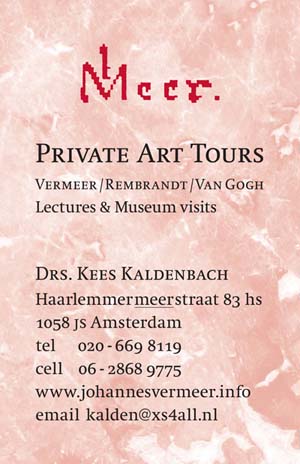 Drs. Kees Kaldenbach,
director
Drs. Kees Kaldenbach,
director
Bullet note File: Kaldenbach for the
8th Biennial Conference
Communicating,
Remembering, Reconstructing
an Interdisciplinary Conference for Low
Countries Studies
Dublin, 6 - 7 January 2010.
Presentation paper on the theme: Technology-enabled learning and
research in the context of Low Countries Studies.
Title:
Dutch cultural history as presented on websites and in museums:
How digital presentations allow new ways of seeking worthwhile
questions, interpretations and answers.
By drs Kees Kaldenbach, independent art historian, Amsterdam.
Modern art history teachers welcome the use of various electronic and
Internet sources and apply interactive techniques. Many museums have also
welcomed various innovative ways of using digital technology in order to
present their stories, ideas and collections.
Today I will discuss a critical assessment of several websites and of
electronic ways of presenting both Dutch history and art history on the Internet and
in museums.
1. A Vermeer website created by Jonathan Janson will be discussed.
http://www.essentialvermeer.com/
2. And some highlights of another Vermeer site created by the present
speaker.
http://www.xs4all.nl/~kalden
3. The Rijksmuseum in Amsterdam has created a wonderful website
presenting very large .JPG images of many thousands of their prize
possessions.
4. Documents and objects as presented in the treasury of the
Koninkliijke Bibliotheek, The Hague + Internet.
http://www.kb.nl/galerie/100hoogtepunten/van1tot100.html
5. Digital presentations such as shown in the Boijmans van Beuningen Museum, Rotterdam
(2007?, 2009), inside on a large projection screen, allowing sorting and
re-grouping of paintings by a wave of the hand. Plus Pippi Longstocking video
project.
6. The Treasury in the basement of the new Amsterdam city archives (Stadsarchief) building,
Vijzelstraat, De Bazel architecture.
http://stadsarchief.amsterdam.nl/
One may also learn from some mistakes made in the past.
7. The Vermeer Centre in Delft, housed in the rebuilt Guild of St Luke
building.
http://www.vermeerdelft.nl/194.pp
I propose a number of quality benchmarks
for future presentations with electronic means.
A. Extensive professional knowledge as the starting point
B. Tell a limited story – a story anyone can grasp mentally and
re-tell
C. Tell this brief story by using enriched means (drama, anecdote, humour,
contrast, conflict, tension) and with passion.
D. Begin with a clear 'menu' so people know what they are going
to get. Or can decide to walk on.
E. Awareness of the Æ- triangular relationship that
exists between
1)
the institution / storyteller,
Æ
2) the objective 3)
the client / reader / end user.
historical event /
object / contents
Both the storyteller and the reader should be enticed to seek worthwhile
questions, interpretations and answers.
The medium is the message, they say. The chosen format shapes the style
of communication and therefore the communication itself.
F. Controversy => OK. It wakes people up.
G. Internet is fine, reproductions are fine but nothing beats the thrill
of the REAL historic object.
 Drs. Kees Kaldenbach,
director
Drs. Kees Kaldenbach,
director
Haarlemmermeerstraat 83 hs
1058 JS Amsterdam
The Netherlands
===== tel. =====
tel.: 020 - 669 8119
cell: 06 - 2868 9775
===============
===== telephone from abroad
=====
tel.: 00-31-20 - 669 8119
Cell phone: 00-31-6 - 2868
9775
===============
- Last updated June 7, 2010 -
Research and copyright by Kees Kaldenbach. A full presentation is on view at www.xs4all.nl/~kalden/